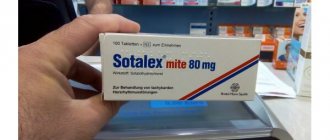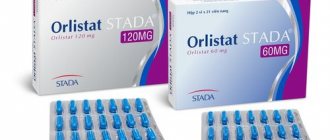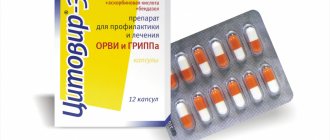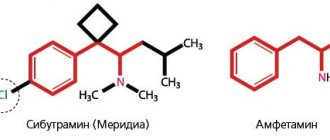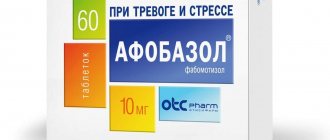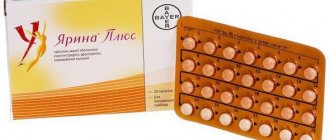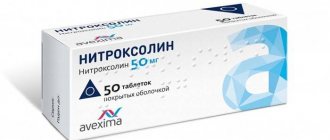Algerica is an antiepileptic , anticonvulsant drug.
The key component of the drug is pregabalin. This active substance has anticonvulsant properties and, in turn, is an analogue of gamma-aminobutyric acid, which contains an alkyl substituent.
Although the molecular structures of these two substances are similar, pregabalin does not have the activity that is characteristic of gamma-aminobutyric acid.
Release form
Algerica is available in the form of opaque capsules of various colors depending on the dosage.
- 25 mg – yellowish tint, black inscription “7622” on the cap;
- 50 mg – yellowish tint, a black radial stripe is placed on the lid and body, “7623” is printed on the lid;
- 75 mg – yellowish tint, pink cap. The case is stamped “7624”;
- 150 mg – yellow tint, black stamp “7626” on the body;
- 300 mg – yellow body, pink cap, black print “7621”.
Inside each capsule is granular white powder (may be partially compressed). Algeric tablets are not available.
Reviews from patients and doctors
Reviews from doctors and patients about Algeric tablets and capsules are negative. And they agree on one thing - take recommendations in exceptional cases!
Reviews from doctors
Doctors do not recommend taking the medicine:
- I prescribe this drug in exceptional cases, since strong side effects do occur (Vasiliev R.A.).
- Algerica is addictive and this has been confirmed by research, but it is difficult to argue with the effectiveness of the drug (Naryshkina Zh.A.).
Patient reviews
Patients also point out the negative effects of the drug on the body:
- They prescribed me this medicine and at first everything was fine, it helped quickly, but then all these side effects just started driving me crazy... and it also took a whole week, or even longer, to finish using it (Roman).
- An excellent drug... although some side effects are troubling, but overall the picture is not bad (Semyon).
- In principle, the drug is effective and worthwhile... but here it also depends on the person. My friend couldn’t take it for a long time, allergic reactions started (Valentin).
In general, it can be seen that Pret Algerica has nothing to do with treatment, it is rather a partially legalized drug.
What can I recommend?
Advice from patients:
- It is better to take with food to reduce the effect on the gastrointestinal tract;
- drink plenty of water;
- Do not use when driving or operating complex machinery.
Narcotic properties of Algerica
There is information that when using this medicine, addiction occurs, therefore patients who are dependent on any medications should use Algerica with extreme caution.
pharmachologic effect
Antiepileptic, anticonvulsant. The active substance is an ankylated analogue of GABA, Pregabalin. The active component is similar in structure to GABA, but does not have the activity characteristic of GABA. Pregabalin does not have a GABAergic effect (indirect or direct).
The principle of action of the drug is based on the ability of the active component to come into contact and bind to a special subunit of calcium voltage-gated channels of neurons. Calcium transport into neuronal cells is reduced compensatoryly in response to the action potential. The active substance is characterized by a special affinity for protein (alpha2-delta), which is located in the nervous system.
With the use of Pregabalin, the production and release of pain neurotransmitters ( norepinephrine , glutamate , substance P ) into synaptic clefts during neuronal excitation decreases. The mechanism of action of the active substance leads to selective suppression of impulse conduction. The drug is characterized by an effect on the network of neurons only in cases of pathology of the nervous system.
Indications for use
The instructions for use for the drug Algerica indicate that there are a number of indications for the use of this medicine.
Here are some of them:
- pain resulting from pathological excitation of neurons in the PNS or central nervous system in adults;
- epilepsy (as an additional treatment for partial seizures accompanied by convulsions);
- a mental disorder characterized by general persistent anxiety that is not related to any specific situations or objects; diffuse symmetrical pain affecting the muscles and skeleton as a whole.
Pharmacodynamics and pharmacokinetics
The active component is characterized by linear pharmacokinetics. The rate of interindividual variability is quite low - less than 20%. There is no need for constant monitoring of the concentration of the active substance during treatment, because the level of Pregabalin after a single dose is equal to its concentration after repeated doses.
Suction
After taking on an empty stomach, the active ingredient is well absorbed from the lumen of the digestive tract. The maximum concentration is recorded 1 hour after a single use. The Tmax indicator does not change after repeated doses. Biological availability is 90% and does not depend on the dosage of the drug.
After repeated administration, Css is achieved within 24-48 hours. Food reduces the degree and rate of absorption of the active substance (Cmax decreases by 25-30%, and Tmax increases by 2.5 hours). In this case, there is no clinically significant effect on the absorption of Pregabalin during food intake.
Distribution, metabolism
The active component is able to bind to plasma proteins. After oral administration, Vd is 0.56 l/kg. Pregabalin is released during lactation and passes through the blood-placental barrier and the BBB.
The active component is almost not metabolized . 1% of the dose taken is metabolized to form the main metabolite N-methylated compound, which is excreted through the renal system. No evidence of racemization of the S-enantiomer into the R-form was detected.
Removal
The main route of elimination is through the renal system. On average, T1/2 is 6.3 hours. Clearance of the active substance from plasma and renal clearance are directly proportional to creatinine .
Contraindications
- pregnancy;
- individual hypersensitivity;
- age limit - up to 18 years;
- lactation.
Relative contraindications:
- therapy with Oxycodone, Lorazepam or Ethanol;
- significant pathology of the renal system;
- diabetes;
- encephalopathy;
- heart failure;
- elderly age;
- drug addiction.
Side effects of Algeric
Organs of vision:
- increased lacrimation;
- strabismus;
- disturbance of visual perception;
- eye irritation;
- diplopia;
- decreased visual acuity;
- mydriasis;
- asthenopia;
- increased brightness of visual perception;
- swelling of the eyes;
- loss of peripheral vision.
Nervous system:
- euphoria;
- dizziness;
- disorientation;
- lack of coordination;
- insomnia;
- irritability;
- decreased libido;
- lethargy;
- imbalance;
- limb tremors;
- ataxia;
- memory impairment;
- sedative effect;
- amnesia;
- nightmares;
- mood lability;
- anorgasmia;
- confusion;
- depersonalization;
- anxiety;
- agitation;
- depressed mood;
- depressed mood;
- myoclonic spasms;
- panic attacks;
- hallucinations;
- dysgraphia;
- difficulty finding words;
- disinhibition;
- fainting;
- loss of taste;
- psychomotor agitation;
- weakening of reflexes;
- nystagmus;
- intention tremor;
- fainting;
- stupor;
- parosmia;
- hypokinesia.
The cardiovascular system:
- 1st degree atrioventricular block;
- sinus bradycardia;
- sinus tachycardia;
- instability of blood pressure (increase/decrease);
- rushes of blood flow to the skin of the face;
- sinus arrhythmia.
Respiratory system:
- nasal congestion;
- dyspnea;
- snore;
- nose bleed ;
- dryness of the nasal mucous membranes;
- rhinitis;
- a feeling of tightness in the oropharynx.
Digestive tract:
- constipation;
- bloating, flatulence ;
- dry mouth;
- ascites;
- hyperesthesia of the oral mucosa;
- increased salivation;
- vomit;
- GERD;
- pancreatitis;
- dysphagia.
Skin:
- cold sweat;
- sweating;
- papular rash;
- hives.
Genitourinary system:
- dysuric manifestations;
- renal failure;
- urinary incontinence;
- oliguria.
Connective tissue, musculoskeletal system:
- pain in the neck;
- muscle stiffness;
- muscle twitching;
- muscle spasms;
- back pain;
- myalgia;
- swelling of the joints;
- Rhabdomyolysis
Reproductive system:
- pain in the mammary glands;
- dysmenorrhea;
- erectile disfunction;
- delayed ejaculation;
- sexual dysfunction;
- discharge from the mammary glands;
- amenorrhea.
Other reactions:
- gait disturbance;
- peripheral edema;
- fatigue;
- feeling of tightness in the chest;
- feeling of intoxication;
- pain;
- chills;
- hyperacusis;
- nasopharyngitis;
- thirst;
- leukopenia;
- hyperthermia;
- vertigo;
- urinary retention;
- generalized edema.
Side effects
The product has a lot of side effects, so it is recommended to prescribe the drug only when absolutely necessary.
Circulatory system
The process of blood formation is influenced by the following effects:
- agranulocytosis;
- a disease in which the number of platelets decreases is pathological.
Metabolism
The following side effects occur increased appetite, changes in body weight.
From the nervous system
The functioning of the central nervous system can be affected by:
- most often there is a feeling of uncertainty in one’s position relative to space, drowsiness;
- clouding of consciousness, nervousness, memory loss, trembling of limbs, sleep and balance disturbances, etc. are also encountered;
- even less common are anxiety, depression, panic attacks, problems associated with impaired word selection, “nightmares”, impaired speech apparatus, fussiness, possible loss of the ability to sense taste, loss of consciousness;
- It is even less common to encounter such symptoms as partial impairment of the ability to write something, the sensation of smells in their complete absence, etc.
Vision, hearing, vestibular system
The normal functioning of the visual organs is affected by:
- most often there is a violation of visual perception, “split” of objects;
- The feeling of dryness in the eyes and pain, excessive tearing, “sparkles” in the eyes and others are not very common.
On the part of the hearing and vestibular apparatus, the following disturbances were observed :
- loss of balance is common;
- Rarely does an increase in the sharpness of sound perception occur.
The cardiovascular system
The cardiovascular system is also subject to some side effects. For example:
- an increase in the amount of blood that flows to some part of the human body;
- increased arterial pressure;
- It is much less common to see an increase in heart rate.
Respiratory system
The respiratory system is exposed to the following influences:
- dyspnea;
- a feeling of dry mucous membranes in the respiratory organs;
- You can rarely find respiratory congestion, nosebleeds, snoring, etc.
The digestive system is affected by:
- bloating;
- nausea;
- feeling of dry mucosa;
- Less commonly, symptoms such as excessive salivation and decreased oral sensitivity may be detected;
- Symptoms such as pancreatitis and swallowing disorders are extremely rare.
You need to know and understand how first aid is provided during an epileptic attack. One day this will save the life of a loved one or a stranger.
In 99 percent of cases, hereditary Huntington's disease ends in the death of the patient. How to make a person’s life as easy as possible and prolong it?
Urinary system
From the excretory system: incontinence and problems with urination occur occasionally.
Musculoskeletal system
Damage to the musculoskeletal system:
- swelling of the joints;
- back pain;
- muscle spasms;
- pain in the limbs;
- various types of muscle spasms;
- occasionally – pain in the neck, etc.
Reproductive system
The reproductive system “suffers” no less than the rest. Typical violations are:
- delayed ejaculation;
- erectile dysfunction.
Sometimes there is pain in the area of the mammary glands and an increase in their size, as well as discharge, etc.
List of side effects compiled from customer surveys
The side effects listed below have been found through the use of pregabalin in practice:
- CNS : headaches, fainting, cognitive impairment.
- Organs of vision . There was a violation of the basic functions of the visual organs.
- Digestive system . Infrequently, swelling of the tongue, nausea, and stomach upset were detected.
- Skin . Swelling of the face and itching were rare.
- The cardiovascular system . Chronic heart failure occurred.
- Disorders of the urinary system are characterized by urine retention.
- The respiratory system can sometimes be subject to swelling of the respiratory organs, in particular the lungs.
Algerica, instructions for use (Method and dosage)
Capsules are intended for oral administration. Daily dosage 150-600 mg (2-3 doses). Capsules are washed down with liquid; breaking or crushing is not allowed.
The treatment regimen and duration of therapy are determined separately for each patient, assessing the characteristics of the underlying disease, concomitant pathology, and tolerability of therapy.
Therapy for neuropathic pain syndrome
Treatment begins with a daily dose of 150 mg of Pregabalin, divided into 2-3 doses. After 3-7 days of therapy, depending on the tolerability of the medication, the daily amount of the drug is increased to 300 mg. If necessary, after a week the dose is increased to 600 mg/day (the maximum dosage allowed by the manufacturer).
Treatment of epilepsy with convulsive partial seizures (additional)
The initial dosage is 150 mg per day (2-3 doses). After a week, the dose is increased to 300 mg. After another week, the amount of medication can be increased to 600 mg (permissible maximum).
Therapy for generalized anxiety disorders
Treatment begins with 150 mg per day (2-3 doses). After a week, the dose is doubled to 300 mg. After another week, if there is no expected reaction, the amount of Pregabalin can be increased to 450 mg per day. After another week, if necessary, the dosage is increased to 600 mg (maximum).
Fibromyalgia Therapy
Treatment with Pregabalin begins with 150 mg per day (2-3 doses). After 7 days, the doctor may increase the dosage to 300 mg. After another week, if there is no expected reaction, the dose of the medication is increased to 450 mg. After another 7 days, the amount of the drug can be increased to a maximum of 600 mg/day.
Algeric is discontinued gradually (at least 1 week).
Directions for use and dosage
Algerica is taken orally, regardless of food intake, with plenty of water. Capsules should be swallowed whole, without crushing or chewing.
The daily dose varies between 150-600 mg, the frequency of administration is 2-3 times a day. The duration of treatment is determined by the doctor individually depending on the indications and individual characteristics of the patient.
The initial daily dose for all indications is 150 mg. After 3-7 days (determined by the response to therapy and individual tolerance), it may increase by 2 times. After another 7 days, if necessary, it can be increased to a maximum of 600 mg.
Cancellation of treatment is carried out gradually - over at least 7 days.
For functional renal impairment, when selecting a dose, take into account creatinine clearance (CC), calculated using the formula:
- Men: CC (ml/min) = (weight in kg) × (140 - age in years)/72 × plasma creatinine concentration (mg/dl);
- Women: CC (ml/min) = 0.85 × CC for men.
For patients on hemodialysis, the daily dose of Algerica is selected taking into account renal function, and immediately after each four-hour hemodialysis session an additional dose must be taken (QC/initial daily dose/maximum daily dose/frequency of use):
- From 60 ml/min: 150 mg/600 mg/2-3 times a day;
- 30-60 ml/min: 75 mg/300 mg/2-3 times a day;
- 15-29 ml/min: 25-50 mg/150 mg/1-2 times a day;
- Up to 15 ml/min: 25 mg/75 mg/1 time per day.
Additional daily dose prescribed once after dialysis: initial - 25 mg, daily - 100 mg.
Dose adjustment for patients with functional liver disorders is not required.
Patients over 65 years of age may be prescribed Algeric in reduced doses due to decreased renal function.
If you miss a single dose, you should take it as soon as possible. You should not take a double dose.
Interaction
Pregabalin rarely interacts pharmacologically with other medications, because does not bind to plasma proteins, is not able to inhibit in vitro metabolism and is excreted unchanged through the renal system.
Pharmacological interaction with Valproic acid , phenytoin , Ethanol, Lamotrigine, Carbamazepine, Lorazepam, Gabapentin, Oxycodone .
Pharmacological analysis has proven that the clearance of Pregabalin is not affected by: Tiagabine, Phenobarbital, Insulin , diuretics, hypoglycemic drugs (oral), Topiramate .
Simultaneous use of oral forms of contraceptives ( Ethinyl estradiol, Norethisterone ) together with Pregabalin does not affect the pharmacokinetics.
Pregabalin is capable of increasing disturbances in motor (basic and mnestic) functions caused by Oxycodone . of Lorazepam may increase while taking Pregabalin.
Weakening of the functions of the lower digestive tract (intestinal obstruction, constipation ) is observed with the use of opioid analgesic drugs.
Replacement medications
Below are analogs of Algeric, as well as the pros and cons of purchasing and using them.
Benzonal
Has anticonvulsant properties. Its composition and pharmacology are similar to phenobarbital, but unlike it:
- has a less harmful effect on the central nervous system;
- the price is lower;
- reduces the frequency of attacks;
- addictive;
- should not be given to children.
Depakin
Anticonvulsant medicine that effectively fights various forms of epilepsy. Has sedative properties.
The mechanism of action is not fully understood:
- helps cope with epilepsy attacks;
- can be prescribed to children;
- effective;
- the price is lower compared to the original drug;
- very toxic, especially the liver “suffers”.
Sabril
An effective medicine that increases the content of gamma-aminobutyric acid in the central nervous system:
- active drug;
- there is a uniform for children;
- overpriced.
special instructions
When weight gain occurs in patients with diabetes , it is recommended to adjust the dosage of hypoglycemic medications. If symptoms of angioedema , Pregabalin therapy is discontinued.
During treatment, visual perception disturbances (loss or decrease in acuity) may develop, which resolve on their own with long-term therapy, as well as after discontinuation of the medication. Cases of renal failure have been reported that are reversible.
The drug may cause drowsiness and dizziness, which increases the risk of accidental falls and injury in older people. Cases of drug dependence have been described. It is unacceptable to perform complex types of work or drive vehicles during treatment.
Algeric's analogues
Level 4 ATC code matches:
Gabagamma
Neurontin
Pagluferal
Topiramate
Convalis
Lamotrigine
Lamictal
Gabapentin
Topamax
Keppra
Pregabalin Richter
Tebantin
- Pregabalin-Canon;
- Lyrics;
- Pregabalin-Richter;
- Prabegin.
Algerica price, where to buy
The average cost of the drug in Russia is 1000 rubles. You can buy Algeric in Ukraine for 400 UAH.
- Online pharmacies in UkraineUkraine
Pharmacy24
- Algerica 75 mg No. 14 capsules Pliva Hrvatska d.o.o., Croatia
160 UAH.order - Algerica 150 mg No. 56 capsules Pliva Hrvatska d.o.o., Croatia
662 UAH. order
- Algerica 150 mg No. 14 drops Pliva Hrvatska d.o.o., Croatia
221 UAH order
- Algerica 150 mg No. 28 capsules Pliva Hrvatska d.o.o., Croatia
397 UAH. order
- Algerica 75 mg No. 28 capsules Pliva Hrvatska d.o.o., Croatia
311 UAH. order
